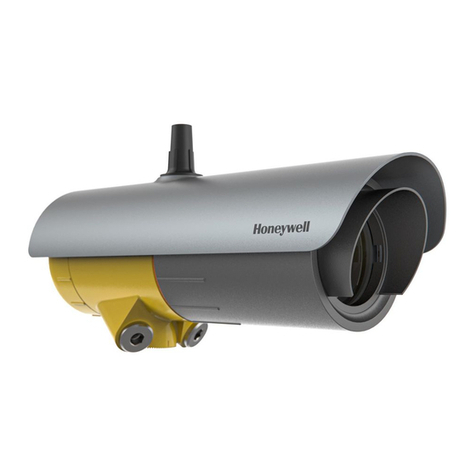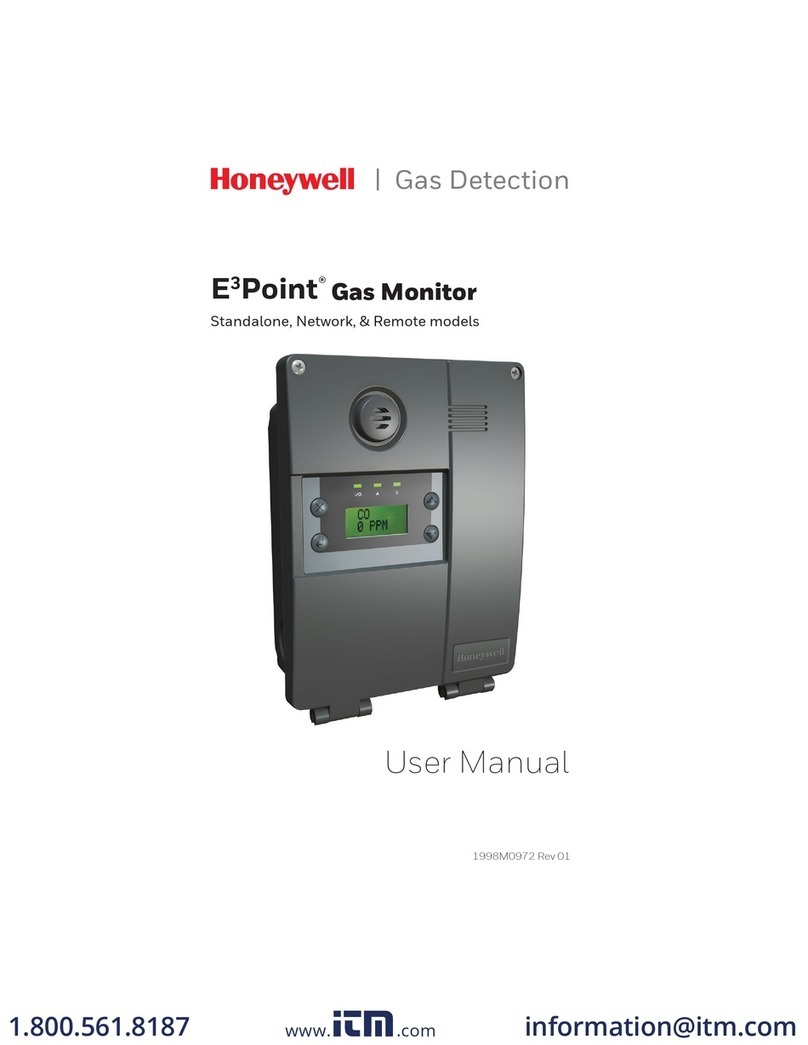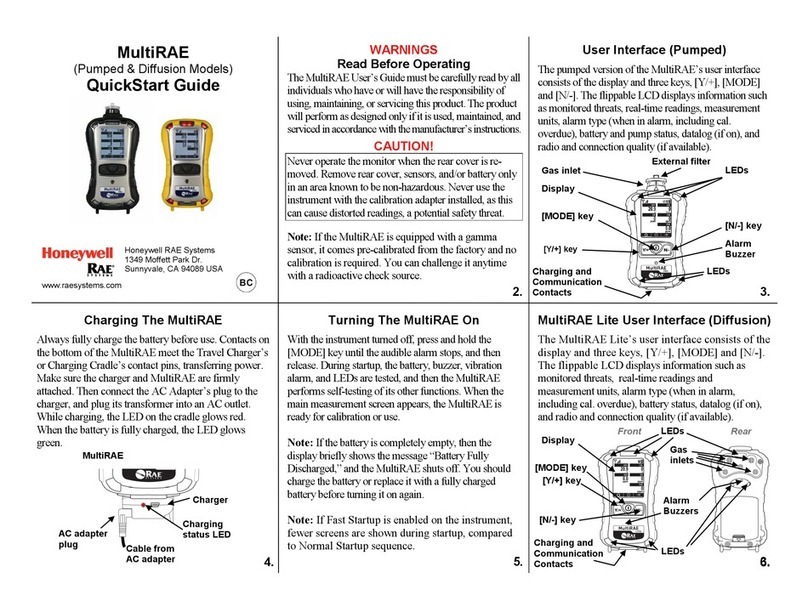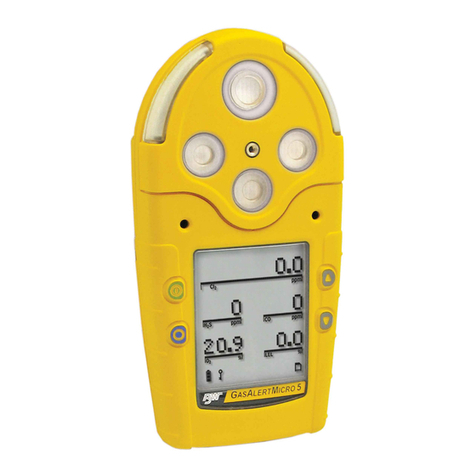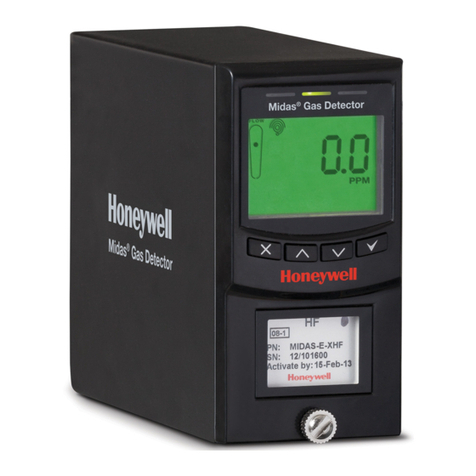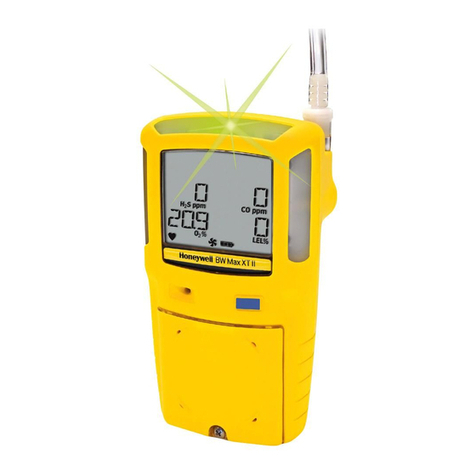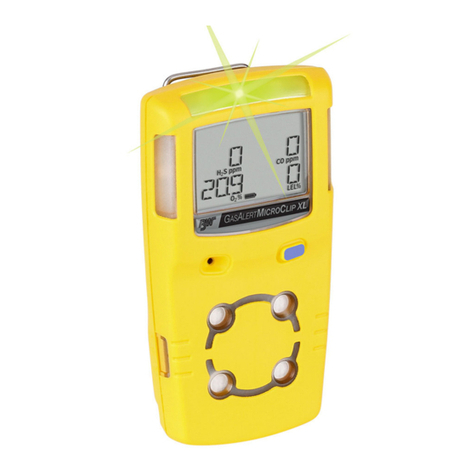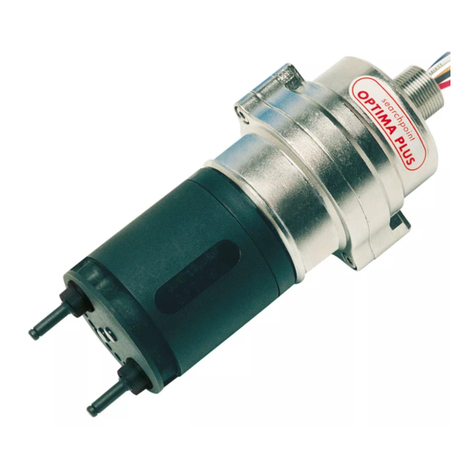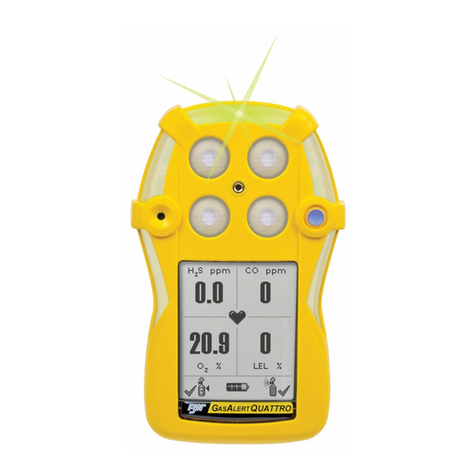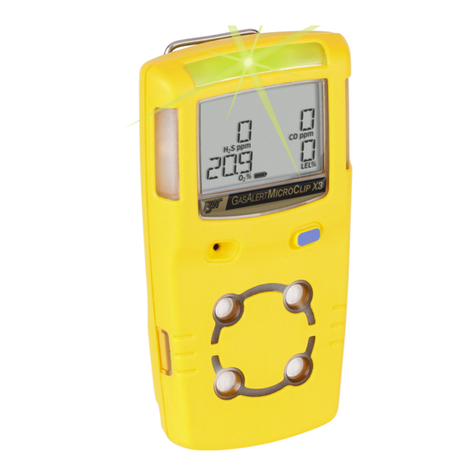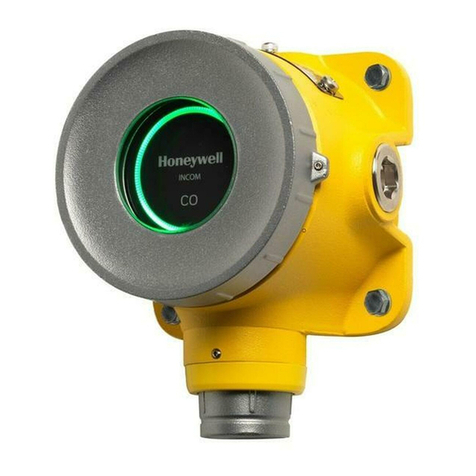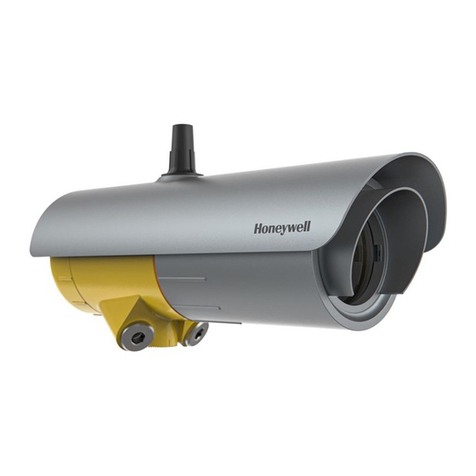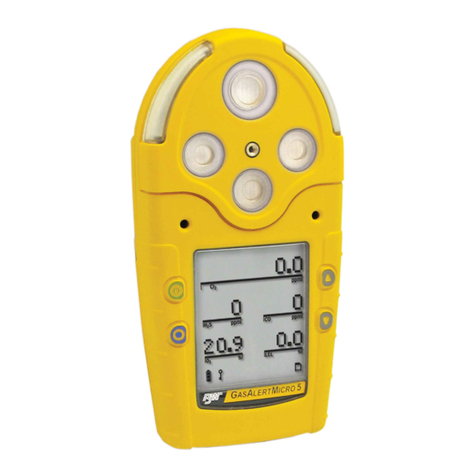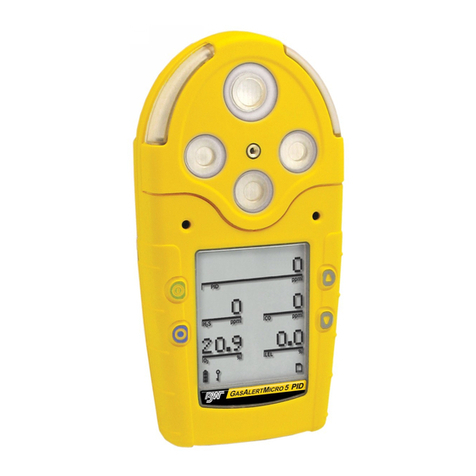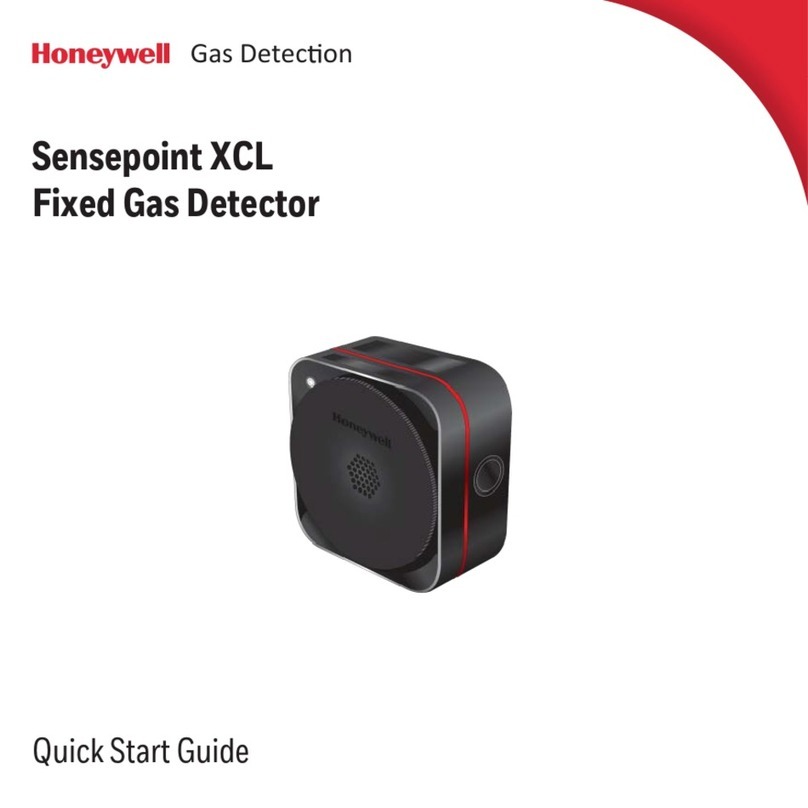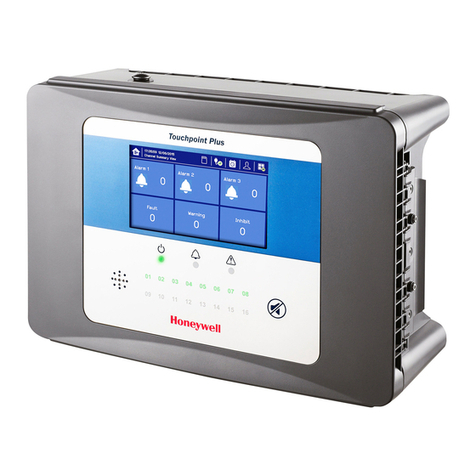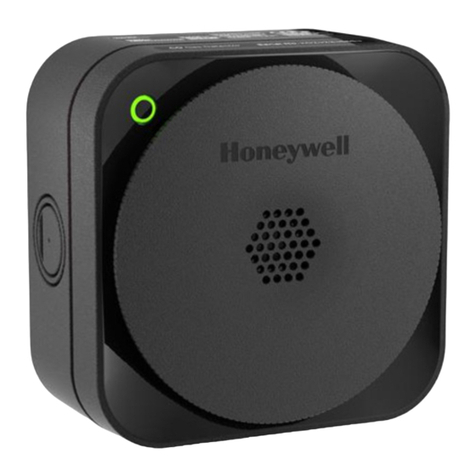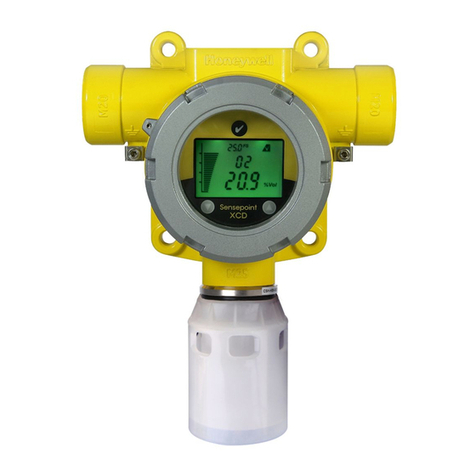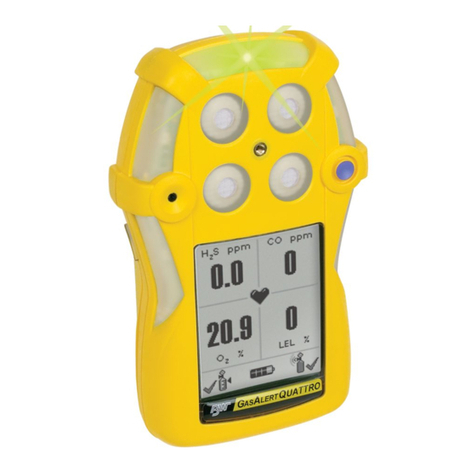
Battery operating time
Toxic, O, and LEL sensor configuration: Three alkaline cells or one lithium battery pack at 20°C/68°F provides 20
hours operating runtime
Toxic, O, LEL, and PID sensor configuration: Three alkaline cells or one lithium battery pack at 20°C/68°F provides
15 hours operating runtime
Toxic, O, LEL, and CO sensor configuration: Three alkaline cells or one lithium battery pack at 20°C/68°F provides
15 hours operating runtime
Approved batteries
Approved batteries for GasAlertMicro 5, GasAlertMicro 5 PID, and GasAlertMicro 5 IR product:
• Alkaline (M5-BAT02): as per standards EN 60079-11, EN 60079-0, UL913, CSA C22.2 No. 157
• Lithium-ion polymer (M5-BAT07): as per standards EN 60079-11, EN 60079-0, UL913, CSA C22.2 No. 157
• Lithium-ion polymer (M5-BAT08): as per standards EN 60079-11, EN 60079-0, EN 60079-29-1, EN 50104, UL913, CSA C22.2 No.
157, EN 45544-1 and EN 45544-2.
Rechargeable battery (M5-BAT08):
Lithium polymer -20°C ≤ Ta ≤ +50°C. Temperature code: T4
Alkaline batteries:¹
Duracell MN1500 -20°C ≤ Ta ≤ +50°C. Temperature code: T4 (129.9°C)
Energizer E91VP -20°C ≤ Ta ≤ +50°C. Temperature code: T3C (135.3°C)
Battery charger: GasAlertMicro 5/PID/IR battery charger
First-time charge: Lithium 6 hours
Normal charge: Lithium 6 hours
Warranty: 2 years including sensors (1 year NH3 sensor and PID lamp)
Year of manufacture: The detector's year of manufacture is determined from the serial number. The second and third
number after the first letter determines the year of manufacture.
Example: H311-001000 = 2011 year of manufacture.
¹Standard release data. This product has extended characteristics. For specifications refer to EAC Ex certificate and Pattern Approval document.
Approvals
GasAlertMicro 5 and GasAlertMicro 5 PID (Zone 0): Approved by CSA to both U.S. and Canadian Standards
Standards: CAN/CSA C22.2 No. 157 and C22.2 152
ANSI/UL – 913 and ANSI/ISA – S12.13 Part 1
ABS Type Approved: VA-348169-X
CSA Class I, Division 1, Group A, B, C, and D. Class I, Zone 0, Group IIC.
ATEX CE 0539 II 1 G Ex da ia IIC T4 Ga
KEMA 06 ATEX 0206
EN 60079-0, EN 60079-1, EN 60079-11
IECEx Ex da ia IIC Ga IECEx CSA 06.0011X
IEC 60079-0, IEC 60079-1, IEC 60079-11
INMETRO Ex d ia IIC T4 Ga DNV 12.0138 X
KTL 12-KB4BO-0055X, 18-KB4BO-0672X
GasAlertMicro 5 IR (Zone 1): Approved by CSA to both U.S. and Canadian Standards
Standards: CAN/CSA C22.2 No. 157 and C22.2 152
ANSI/UL – 913 and ANSI/ISA – S12.13 Part 1
ABS Type Approved: VA-348169-X
CSA Class I, Division 1, Group A, B, C, and D. Class I, Zone 0, Group IIC.
ATEX CE 0539 II 2 G Ex d ia IIC Gb
KEMA 06 ATEX 0206
EN 60079-0, EN 60079-1, EN 60079-11,
IECEx Ex d ia IIC Gb IECEx CSA 06.0011X
IEC 60079-0, IEC 60079-1, IEC 60079-11
INMETRO Ex d ia IIC T4 Gb DNV 12.0138 X
KTL 18-KB4BO-0673X
For more information on Approvals and Conformity Declarations refer to https://safety.honeywell.com
This equipment has been tested and found to comply with the limits for a Class B digital device, pursuant to Part
15 of the FCC Rules and ICES-003 Canadian EMI requirements. These limits are designed to provide reasonable
protection against harmful interference in a residential installation. This equipment generates, uses and can radiate
radio frequency energy and, if not installed and used in accordance with the instructions, may cause harmful
interference to radio communications. However, there is no guarantee that interference will not occur in a particular
installation. If this equipment does cause harmful interference to radio or television reception, which can be
determined by turning the equipment off and on, the user is encouraged to try to correct the interference by one or
more of the following measures:
• Reorient or relocate the receiving antenna.
• Increase the separation between the equipment and receiver.
• Connect the equipment into an outlet on a circuit different from that to which the receiver is connected.
• Consult the dealer or an experienced radio/TV technician for help.
Information Required for European Regulations Compliance
Should the user wish to comply, the detector must be operated in the following manner.
Daily bump test: A bump test must be completed before each day’s use.
Condition of use: The detector may only be used with the concussion-proof boot (GA-BM5-1 if it is a diffusion unit, or
GA-BM5-2 if it is a pump unit).
Stealth mode: Stealth mode must be disabled.
Latching alarms: The latching alarm option must be enabled.
Warm up time: 60 seconds; ≤ 90 seconds for pump unit
Stabilization time for methane sensor: ≥ 120 seconds
Stabilization time for oxygen sensor: ≥ 120 seconds
Methane response time t: 10 seconds
Oxygen response time t: 15 seconds for oxygen deficiency
Oxygen response time t: 14 seconds for oxygen surplus
Changing measurement range from % LEL to % Vol.: If changing the measurement unit from % LEL to % Vol. or
from % Vol. to % LEL, a calibration must be completed and the alarm setpoints changed. For calibration information
refer to Calibration chart and for alarm setpoint information refer to the GasAlertMicro 5/PID/IR User Manual.
Effect of other toxic gases on the LEL sensor: High concentrations of certain toxic gases, for example HS, may
have an adverse effect on the LEL sensor. This effect, known as inhibition, is usually temporary but in extreme
circumstances can impair the sensitivity of the LEL sensor. After any gas exposure that causes an alarm in the toxic
gas sensors, the LEL sensor should be verified with a bump test, and recalibrated if necessary.
Approved batteries for GasAlertMicro 5, GasAlertMicro 5 PID, and GasAlertMicro 5 IR product: Lithium-ion
polymer (M5-BAT08): as per standards EN 60079-11, EN 60079-0, UL913, CSA C22.2 No. 157
General Use: For use only in potentially explosive atmospheres where oxygen concentrations do not exceed 20.9%
(v/v). Oxygen deficient atmospheres (<10% v/v) may suppress some sensor outputs.
Limited Warranty and Limitation Liability
Honeywell Analytics warrants the product to be free from defects in material and workmanship under normal use
and service for a period of two years, beginning on the date of shipment to the buyer. This warranty extends only to
the sale of new and unused products to the original buyer. Honeywell’s warranty obligation is limited, at Honeywell’s
option, to refund of the purchase price, repair or replacement of a defective product that is returned to a Honeywell
authorized service center within the warranty period. In no event shall Honeywell’s liability hereunder exceed the
purchase price actually paid by the buyer for the Product.
This warranty does not include:
a. fuses, disposable batteries or the routine replacement of parts due to the normal wear and tear of the product arising from use;
b.any product which in Honeywell’s opinion, has been misused, altered, neglected or damaged, by accident or abnormal conditions of
operation, handling or use;
c. any damage or defects attributable to repair of the product by any person other than an authorized dealer, or the installation of unapproved
parts on the product; or the obligations set forth in this warranty are conditional on:
d.proper storage, installation, calibration, use, maintenance and compliance with the product manual instructions and any other applicable
recommendations of Honeywell;
e. the buyer promptly notifying Honeywell of any defect and, if required, promptly making the product available for correction. No goods shall
be returned to Honeywell until receipt by the buyer of shipping instructions from Honeywell; and
f. the right of Honeywell to require that the buyer provide proof of purchase such as the original invoice, bill of sale or packing slip to establish
that the product is within the warranty period.
THE BUYER AGREES THAT THIS WARRANTY IS THE BUYER’S SOLE AND EXCLUSIVE REMEDY AND IS IN LIEU OF
ALL OTHER WARRANTIES, EXPRESS OR IMPLIED, INCLUDING BUT NOT LIMITED TO ANY IMPLIED WARRANTY OF
MERCHANTABILITY OR FITNESS FOR A PARTICULAR PURPOSE. HONEYWELL SHALL NOT BE LIABLE FOR ANY
SPECIAL, INDIRECT, INCIDENTAL, OR BASED ON CONTRACT, TORT OR RELIANCE OR ANY OTHER THEORY.
Since some countries or states do not allow limitation of the term of an implied warranty, or exclusion or limitation of
incidental or consequential damages, the limitations and exclusions of this warranty may not apply to every buyer. If
any provision of this warranty is held invalid or unenforceable by a court of competent jurisdiction, such holding will
not affect the validity or enforceability of any other provision.
Contact
Europe, Middle East, Africa
Life Safety Distribution GmbH
Life Safety Distribution GmbH
Javastrasse 2
8604 Hegnau
Switzerland
Toll-Free 00800 333 222 44
Middle East +971 4 450 5800
Middle East +971 4 450 5852
(Portable Gas Detection)
gasdetection@honeywell.com
Technical Services
EMEA: HAexpert@honeywell.com
US: ha.us.service@honeywell.com
AP: ha.ap.service@honeywell.com
Americas
Honeywell Analytics Distribution Inc.
405 Barclay Boulevard
Lincolnshire, Illinois.
USA 60069
Tel: +1 847 955 8200
Toll free: +1 800 538 0363
detectgas@honeywell.com
Asia Pacific
Honeywell Analytics Asia Pacific
7F SangAm IT Tower,
434 Worldcup Buk-ro, Mapo-gu,
Seoul 03922, South Korea
Tel: +82 (0) 2 6909 0300
India Tel: +91 124 4752700
analytics.ap@honeywell.com
https://safety.honeywell.com
WEEE Directive and Battery Directive
This symbol indicates that the product must not be disposed of as general industrial or domestic waste.
This product should be disposed of through suitable WEEE disposal facilities.
For more information about disposal of this product, contact your local authority, distributor or the
manufacturer.
Factory Calibration Certificate
We are committed to providing quality product. This instrument has undergone rigorous testing throughout its
manufacture. This is the final report by the people that take pride in the products they build.
This instrument has been factory inspected, tested, and calibrated in accordance with the conditions and
requirements of our registered Quality System, Operating Standards, and Sales Agreements.
Place Factory Calibration
Certification here
User Options Menu
To access the user options, press and hold 🔼and 🔽simultaneously until the detector completes the countdown.
To scroll through the options press 🔼or 🔽. Press ○to select the option.
Exit: Exits the user options menu.
For more information about the User Options Menu, refer to the GasAlertMicro 5, GasAlertMicro 5 PID, and
GasAlertMicro 5 IR User Manual provided on the Honeywell https://safety.honeywell.com web site.
Maintenance
To maintain the detector in good operating condition, perform the following basic maintenance as required.
• Calibrate, bump test, and inspect the detector on a regular schedule.
• Maintain an operations log of all maintenance, bump tests, calibrations, and alarm events.
• Clean the exterior with a soft damp cloth. Do not use solvents, soaps, or polishes. Refer to Sensor Poisons and Contaminants table.
• Do not immerse the detector in liquids.
For more information about Maintenance, refer to the GasAlertMicro 5, GasAlertMicro 5 PID, and GasAlertMicro 5 IR
User Manual provided on the Honeywell https://safety.honeywell.com web site.
Replacing Battery Cells and Packs
To avoid personal injury and/or property damage, adhere to the following battery cautions:
aec WARNING
• This instrument contains alkaline batteries. Do not mix with the solid waste stream. Spent batteries must be disposed of by a qualified
recycler or hazardous materials handler.
• This instrument contains a lithium polymer battery. Dispose of lithium cells immediately. Do not disassemble and do not dispose of in
fire. Do not mix with the solid waste stream. Spent batteries should be disposed of by a qualified recycler or hazardous materials handler.
• Replace the alkaline cells or rechargeable battery pack immediately when the detector emits a low battery alarm.
• Use only batteries that are recommended by Honeywell.
• Use only approved alkaline batteries that are properly installed in the battery pack. Refer to Specifications.
• To order lithium battery packs (M5-BAT08/M5-BAT07), contact Honeywell.
• Charge the batteries and battery packs using only a recommended Honeywell charger. Failure to adhere to this caution can lead to fire
and/or explosion.
• The detector must be deactivated to charge the battery pack.
• Do not calibrate the detector immediately after charging is complete.
• Boththe lithium batterypack and thealkaline battery packare user-changeable inhazardous locations, butthe alkaline battery cells inside
the pack can only be replaced in a safe area that is free of hazardous gas.
• The M5-BAT08 and M5-BAT07 battery packs are equipped with lithium batteries that can present a risk of fire or chemical burn hazard
if misused. Do not recharge, disassemble, heat above 212°F (100°C), or incinerate.
• Do not use any other lithium batteries with the GasAlertMicro 5, GasAlertMicro 5 PID, and GasAlertMicro 5 IR detectors. Use of any other
cell can cause fire and/or explosion.
• Lithium polymer cells exposed to heat at 266°F (130°C) for 10 minutes can cause fire and/or explosion.
• Keep lithium cells away from children.
For more information about replacing battery cells and packs, refer to the GasAlertMicro 5, GasAlertMicro 5 PID, and
GasAlertMicro 5 IR User Manual provided on the Honeywell https://safety.honeywell.com web site.
Specifications
Instrument dimensions: 14.5 x 7.4 x 3.8 cm (5.7 x 2.9 x 1.5 in.)
Weight: 370 g (13.1 oz.)
Operating temperature:
• VOC: -10°C to +40°C (14°F to +104°F)¹
• Other gases: -20°C to +50°C (-4°F to +122°F)
• Combustible gas sensor: Certified by CSA International to ±3%
• LEL accuracy from -10°C to +40°C (4°F to 104°F)
Storage temperature: -25°C to +60°C
Operating humidity:
• O: 0% to 90%¹ relative humidity (non-condensing)
• VOC: 0% to 95% relative humidity (non-condensing)
• Combustibles: 5% to 95% relative humidity (non-condensing)
• Cl: 10% to 95% relative humidity (non-condensing)
• HCN, ClO: 15% to 90%¹ relative humidity (non-condensing)
• Other gases: 15% to 90%¹ relative humidity (non-condensing)
Pressure: 95 to 110 kPa¹
Dust and moisture ingress: IP65/66¹
Alarm setpoints: May vary by region and are user-defined
Detection range:
• O: 0 - 30.0% vol. (0.1% vol. increments)¹
• CO: 0 - 999 ppm (1 ppm increments)
• CO (TwinTox sensor): 0 - 500 ppm (1 ppm increments)
• HS: 0 - 500 ppm (1 ppm increments)
• HS (TwinTox sensor): 0 - 500 ppm (1 ppm increments)
• Combustible (LEL): 0 - 100% LEL (1% LEL increments) or 0 - 5.0% v/v methane; certified by CSA International to C22.2 No. 152 and
ISA 12.13.01 within 0 - 60% or 3.0% v/v methane
• PH: 0 - 5.0 ppm (0.1 ppm increments)
• SO: 0 - 150 ppm (1 ppm increments)
• Cl: 0 - 50.0 ppm (0.1 ppm increments)
• NH: 0 - 100 ppm (1 ppm increments)
• NO: 0 - 99.9 ppm (0.1 ppm increments)
• HCN: 0 - 30.0 ppm (0.1 ppm increments)
• ClO: 0 - 1.00 ppm (1.00 ppm increments)
• O: 0 - 1.00 ppm (0.01 ppm increments)
• VOC: 0 - 1000 ppm (1.0 ppm increments)
• CO IR: 0 - 50,000 ppm (50 ppm increments) or 0-5.0% v/v CO
Sensors not certified for use with the GasAlertMicro 5 IR: ClO, HCN, NO, PH, Cl
Sensor type:
• HS/CO: Twin plug-in electrochemical cell
• Combustibles: Plug-in catalytic bead
• VOC: Photoionization detector (PID)
• CO: IR detector
• Other gases: Single plug-in electrochemical cell
O measuring principle: Capillary controlled concentration sensor
Alarm conditions: TWA alarm, STEL alarm, low alarm, high alarm, multi alarm, over limit (OL) alarm, sensor alarm,
pump alarm, MMC/SD fail alarm, low battery alarm, confidence beep, automatic deactivation alarm
Audible alarm: 95 dB at 0.3 m (1 ft.) variable pulsed dual beepers
Visual alarm: Dual red light-emitting diodes (LEDs)
Display: Alphanumeric liquid crystal display (LCD)
Backlight: Activates briefly during startup, when there is insufficient light to view the display (if enabled), and during
alarm conditions
Self-test: Initiated during activation
Calibration: Automatic zero and automatic span
Oxygen sensor: Automatic span during startup (if enabled)
User field options: Confidence beep, latching low and high alarms, passcode protection, enable/disable safe display
mode, combustible sensor measurement, sensor enable/disable, language selection, enable/disable automatic
O calibration, set span concentration values, set STEL calculation period, set TWA method, gas measurement
resolution, enable/disable automatic backlight, adjust clock/calendar, set datalogging rate (datalog models only),
CO sensor measurement
Datalog Models Approved for GasAlertMicro 5 and GasAlertMicro 5 PID Models: Delkin 128 MB SD card and 64
MB Unigen SD card
Datalog Models Approved for GasAlertMicro 5 IR Models: Delkin 128 MB MMC, Delkin 128 MB SD card,
Transcend 128 MB SD, and 64 MB Unigen SD card
¹Standard release data. This product has extended characteristics. For specifications refer to EAC Ex certificate and Pattern Approval document.
https://sps.honeywell.com
50105442-036 EN Rev.N
©2021 Oct 25, All rights reserved
